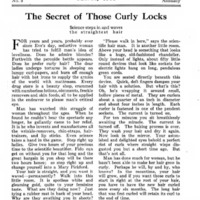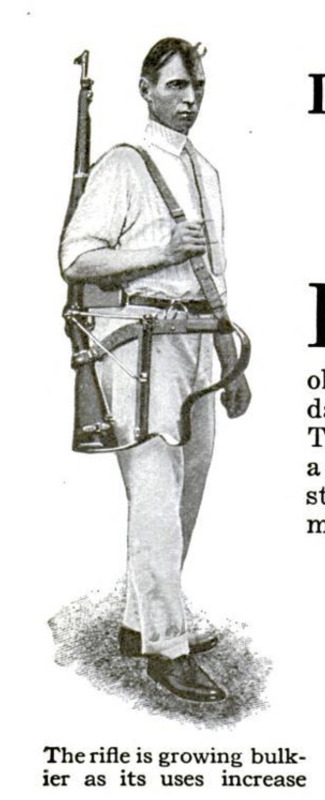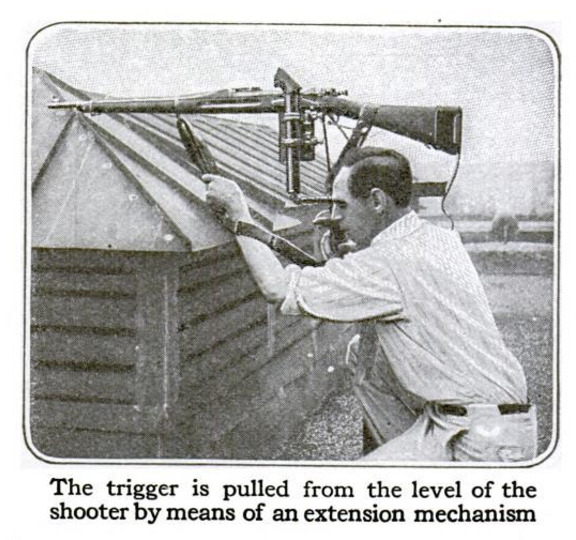Rifle with periscope attachement
Item
-
Title (Dublin Core)
-
Rifle with periscope attachement
-
Article Title and/or Image Caption (Dublin Core)
-
Indirect Fire from Springfields. A periscope attachment and a twenty-five-shot magazine are two of the important improvements
-
Caption 1: The rifle is growing bulkier as its uses increase
-
Caption 2: The trigger is pulled from the level of the shooter by means of an extension mechanism
-
extracted text (Extract Text)
-
PERISCOPE at-
tachments for
the rifle are an
old story from the
days of 1915 when
Tommy Atkins put
a rude contrivance of
sticks and pocket
mirrors on his Lee-
Enfield and
went to potting
at the Germans
across the way.
Periscope, in case
you've forgotten,
means in this con-
nection merely”
an arrangement
of two mirrors,
one up in the line of sight on the barrel of
the rifle, the other down at the level of
the eye, well below the trench parapet,
enabling the soldier to aim and fire the |
rifle while remaining far below the line |
of the barrel.
The new combination developed by our
Army Ordnance Bureau is put on with-
out permanent alteration of the rifle.
Our Ordnance Officers look with jaun-
diced eye on anything for the rifle that
entails machining or alteration of the gun.
The periscope is so mounted that the |
shooter can stand below the lip of the
trench parapet, protected from the over-
head fire of shrapnel, which is not true of
all periscopes. Also it is so hung that the |
recoil of the rifle swings the lens away |
from the eye, instead of pushing the
shooting optic all over the face as is the |
case with some periscopes. An extension |
enables the trigger to be pulled from the
level of the shooter.
The second point is that the rifle is
fitted with a twenty-five-shot magazine in- |
stead of the customary five shots of the ser-
vice rifle. The change is made by merely
sliding the present floor-plate out and
sliding the top of the frame of the new
magazine into its place. This enables a
great number of shots to be fired without |
taking the rifle down to reload. The
Germans are said to have fitted up a num-
ber of their Mausers with these large
capacity magazines some time ago. There
is without doubt, much need for greater
capacity than the present five-shot, clip-
loading magazine.
The third novel point about the con-
verted rifle is the use of translucent rear
sight, colored red or green. The front
sight is colored the one or the other of the
contrasting colors—green when the rear
sight is red, and vice-versa. The in-
ventor, trying out his rifle in actual trench
fighting, found that with the ordinary
metallic sights, showing, of course, merely
black in silhouette against a mark and
hard to distinguish, the rifleman could not
always define the objective, as the greenish
uniform of the German soldiers did not
throw them up in sharp relief. Often mist
confused the issue still more. So he evolved
the contrasting front sight, a vivid green
or a violent red.
The advantage of the translucent slide
is that it does not cover up the mark, and
enables the rifleman to pick it up much
more quickly than is possible when using
the steel slide with the small aperture of
the service rifle. This should prove very
valuable in trench fighting.
-
Contributor (Dublin Core)
-
Edward C. Crossman (writer)
-
Language (Dublin Core)
-
eng
-
Date Issued (Dublin Core)
-
1918-03
-
pages (Bibliographic Ontology)
-
388
-
Rights (Dublin Core)
-
Public Domain (Google digitized)
-
Archived by (Dublin Core)
-
Filippo Valle
-
Alberto Bordignon (Supervisor)
 Popular Science Monthly, v. 92, n. 3, 1918
Popular Science Monthly, v. 92, n. 3, 1918





